Housing markets adjust<br> as recession hits Mexico
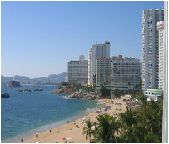
Mexico’s housing markets are adjusting to a recession in the US and to weak Mexican GDP growth, and also to the much-publicized drug-related violence which is turning foreign buyers off.
Sales have reportedly been falling fast in the coastal luxury market, though in Mexico there is no systematic data, so assessing the damage is more art than science. Vacation property sales are reportedly down anywhere from 12% to 60% in September 2008, in different locations, as compared to a year earlier.
Mexico has long been marketed as the perfect retirement haven for American baby-boomers. It has excellent beaches and pleasant coastal towns. Property prices are significantly lower than in California or Florida. In 2006 and 2007, when the US house price bubble was at its peak, many American developers started building luxury resorts and retirement communities.
However, the massive new flood of American buyers never came. The drug crisis with its link to violence and organized crime turned buyers off, as did numerous stories of dubious titles and victimized property investors.
The drop in sales prompted one Mexican senator to propose a revision of the constitution to allow foreigners to directly own properties in Mexico, instead of the current fideicomiso or bank trust system. If approved, this could significantly boost foreign demand.
No price boom in the local market

Property prices in Mexico’s local market have been relatively flat, except for some pockets of development (there are no official or authoritative house price indices).
Demand for property typically drops on economic and/or political crises. When times are less troubled, developers seize the moment, and start building, leading to a construction boom.
Rental units comprised 3.6 million out of 25.7 million (14%) housing units in 2007, largely concentrated in Mexico City and other major cities, according to CONAVI (Comision Nacional de Vivienda or National Housing Commission). Around 70% of households which rent, have below-minimum wage incomes.
Enormous strides forward
Though Mexico’s market is plagued by problems, it has made enormous strides over the past decade. The problems include lack of transparency, limited access to housing finance, slow foreclosure procedures, and antiquated public property registries.
One indicator of progress is that Mexico’s houses are increasingly built by developers, not self-built. Though housing construction in Mexico is still highly informal, only around 30% of new houses in 2006 were self-built, down from 70% in 2000.
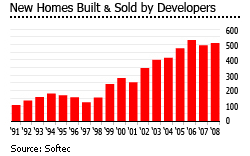
In Mexico as a whole, around 500,000 new homes were built and sold by developers in 2007 and 2008, down from 530,000 units in 2006. Most of this went into the local market. Infonavit, Mexico’s federal housing fund, supports the low-end market, and new loans by Infonavit are expected to reach 500,000 in 2009, the same level as 2008.
Some real estate agents estimate that around 2 million Americans own real estate in Mexico, around half of them living there permanently. In 2007, Mexico had around 4,300,000 vacation properties (including timeshares) in its coastal regions, around 70% of them belonging to foreigners.
Housing finance
Before the worldwide financial crisis hit, Mexico had been experiencing a decade-long housing boom spurred by a massive expansion of state financing for low-income buyers.
From 2005 to 2008, around 500,000 housing units were completed annually by developers, up from an average of 150,000 units 1994 to 1998.
Around 75% of the units were intended for low-income and poor households. In 2008, for instance, 50% of the completed units were for the ‘economic’ segment, 25% for the ‘social’ segment, 20% for the ‘middle’ segment and only around 5% for ‘residential’ and ‘residential plus’ segments.
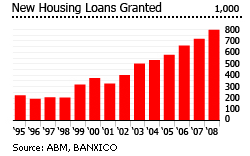
The government provides housing finance for low-income households mainly through INFONAVIT (Instituto del Fondo Nacional para la Vivienda de los Trabajadores or National Fund for Worker’s Housing Institute). The low-end segments are also served by Fovissste (Housing Fund for Public Sector Workers) and Sofoles (special-purpose non-bank financial institutions), sometimes co-financing with Infonavit. Sofoles also provides some mid-market loans.
In 2007:
- Infonavit provided 61% of mortgages
- Sofoles provided 10% of mortgages
- Fovissste granted 9% of mortgages
- Banks provided 20% of mortgages. Banks totally dominate high-end market segments.
Although the number of housing loans granted rose from 327,000 in 2001 to 797,000 in 2008, this was still short of the government’s target - 1 million new loans, due to credit constraints associated with the global financial.
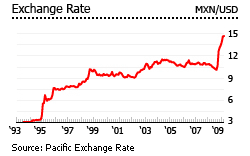
Why such an aggressive target? Because Mexico’s population is young and growing fast, and Mexico’s ‘housing deficit’ – i.e., inadequately-housed households – is estimated at around 5 million units (early-2009), and may rise by around 700,000 units annually over the next 21 years. Nevertheless due to the crisis Infonavit has reduced its 2009 financing target, from 550,000 new loans, to 500,000.
Almost all houses sold by developers get financing from one of the four major sources. The increase in the amount allocated for mortgage financing is directly correlated with the expansion of developer-built housing.
Better lending conditions
Since 2000, banks have made significant changes that have led to better access to loans, and more favorable lending conditions.
- Loan terms have been lengthened from 10 - 15 years in 2000, to the current level of up to 30 years.
- Mortgage processing fees have been reduced to an average of 3%, from 6%.
- Loan to value ratios have been raised to 80% – 90% from 65% or lower.
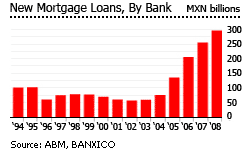
From 2005 onwards, banks aggressively increased their mortgage portfolios. New mortgage loans rose from MXN75 billion (US$5.3 billion) in 2004, to MXN 135 billion (US$9.5 billion) in 2005, and MXN296 billion (US$20.7 billion) in 2008.
Most mortgages issued by banks have interest rates fixed for the duration of the loan term.
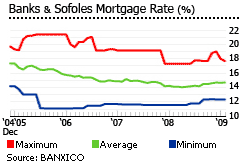
Nevertheless, housing finance is available only to a small fraction of the population. Out of the 44.7 million labour force in 2007, only 4.5 million were eligible for mortgages in September 2008.
The mortgage market, at around 10% of GDP in 2007, is significantly smaller than other OECD-member countries. Mortgage interest rates remain high - the average rate for banks and Sofoles was 14.7% in February 2009.
Constitutional ban

Foreigners might invest more, if there was no constitutional ban on the foreign ownership of land. Under the current system of fideicomiso, foreigners can only indirectly own real estate, by setting up bank trusts.
Although the system is relatively safe, it rests on the credibility of Mexico’s banking system and property registry administration, which unfortunately discourages many foreigners.
Recession once more
Mexico’s economy has weakened now that the US is in recession. GDP marginally rose by an average of 0.3% q-o-q during the first three quarters of 2008, but then contracted by 1.7% in Q4.
Mexico’s GDP growth in 2008 fell to 1.8%, down from 3.2% in 2007. Mexico’s average GDP growth rate was 4% from 2004 to 2006.
Mexico’s economy, Latin America’s second largest, is highly dependent on the US, in terms of investments, exports, wages and unemployment, and private consumption.
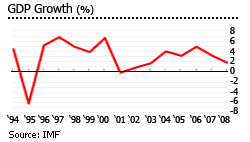
More than 80% of Mexico’s exports go to the US. Remittances from more than 11 million Mexicans in the US amounted to US$24 billion in 2008, about 3% of GDP.
Mexico’s economic contraction is expected to continue in 2009, with GDP shrinking by as much as 3%. Recessions are all too familiar for Mexicans. The last one was in 2001, after the US techno-bubble burst and the 9-11 attacks.
To reduce the recession’s impact, the government has increased the amount available for housing and small business loans.